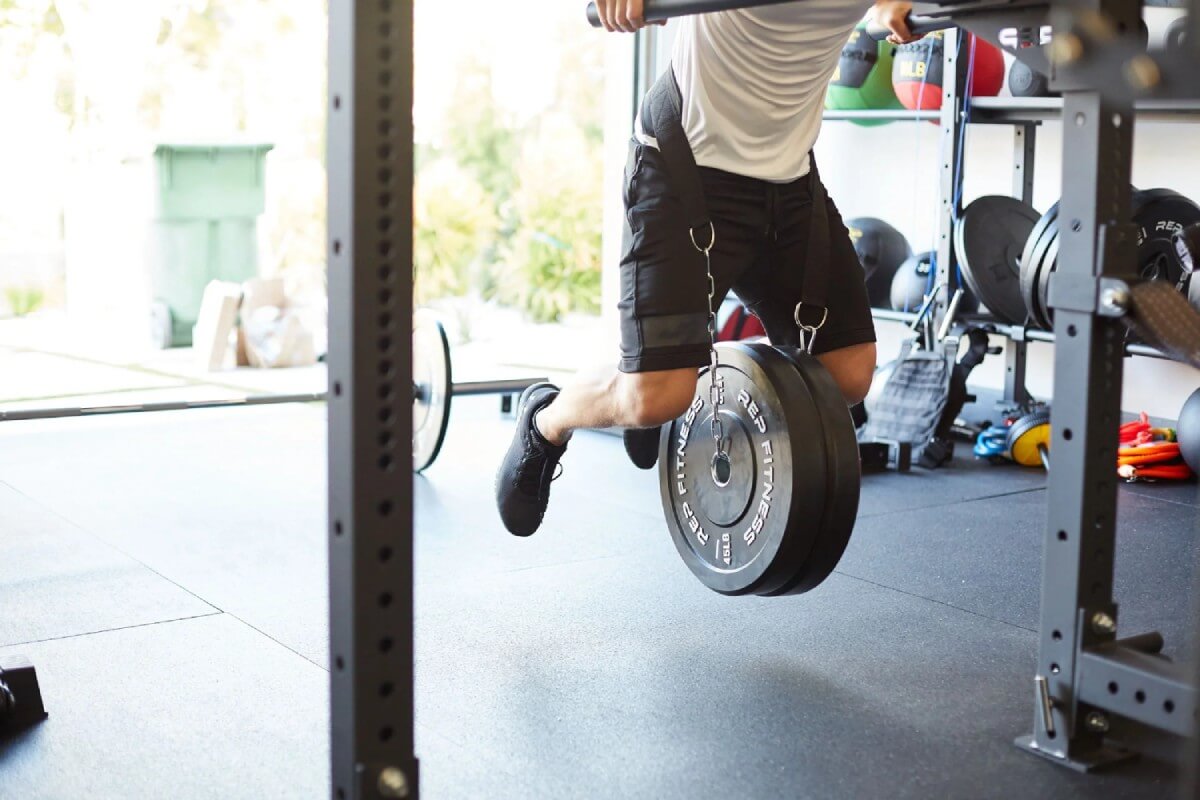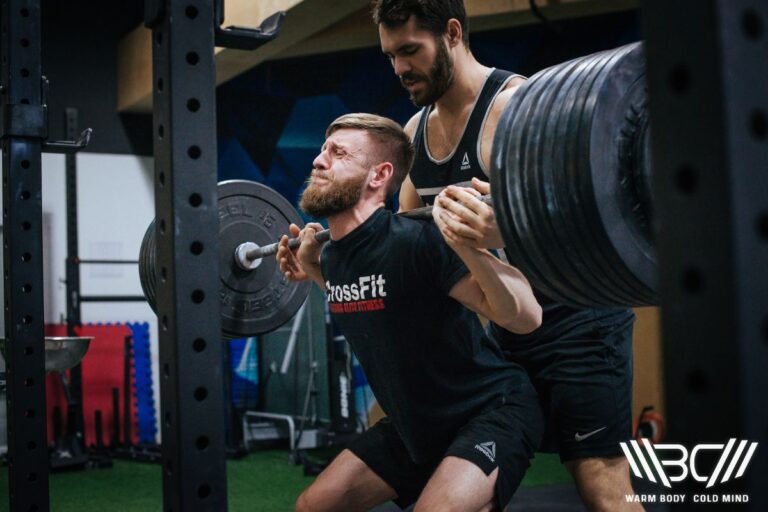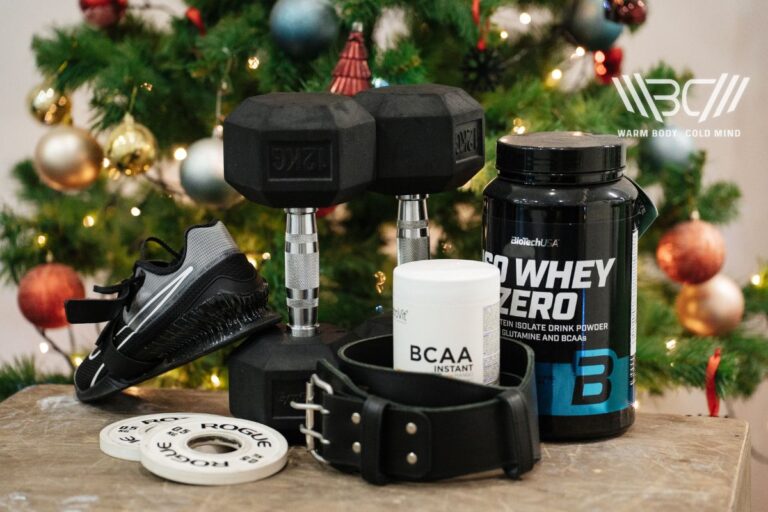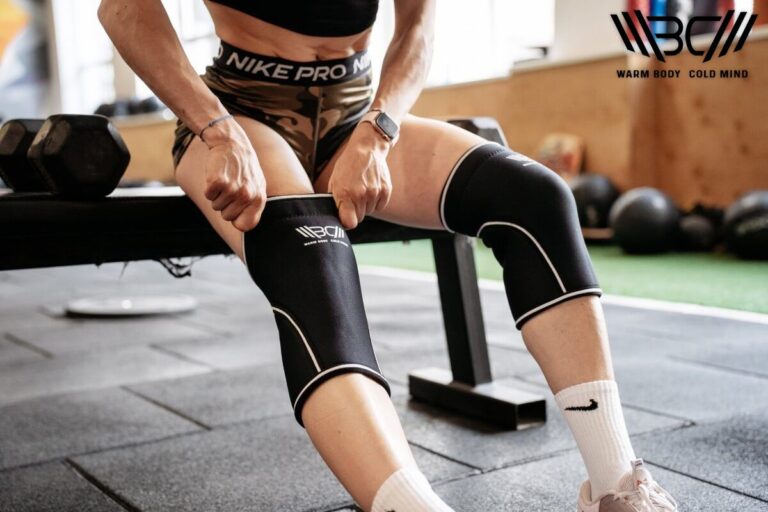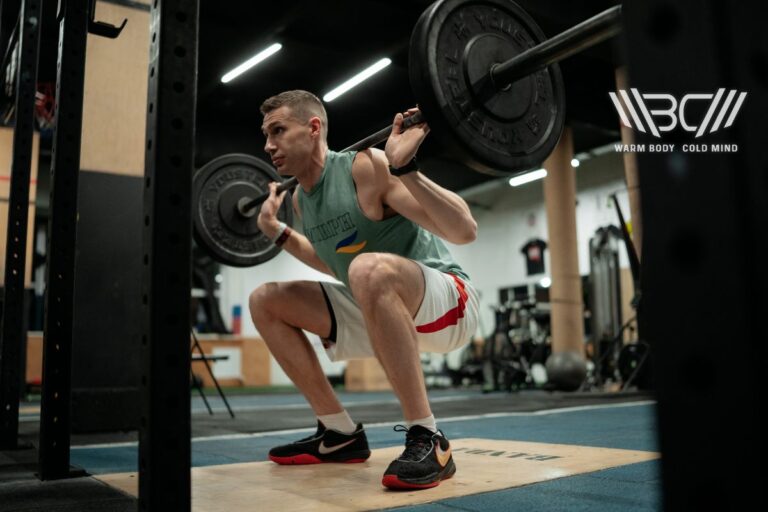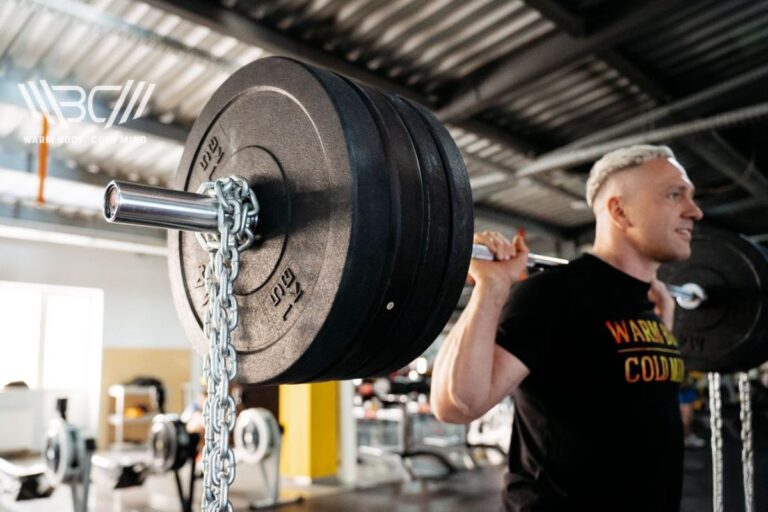Weighted Dips 101 – A Definitive Guide
Weighted dips are versatile compound exercises that are great for improving upper body strength, power, and functional mobility when performed correctly.
To help you learn more, we’ve provided an in-depth discussion below. We’ve looked at the muscles worked, benefits, how to do them correctly, and common variations and alternatives that you can add to your gym routine.
Weighted Dips – Weighted chest dips are a compound exercise that mainly works your chest, triceps, and anterior shoulders. Benefits include improved lockout strength and overhead stability. They have a steep initial learning curve and can cause injury when performed incorrectly. Several variations and alternatives can be done depending on ability.
Weighted Dips 101
Weighted dips are a strength-training exercise that require you to lift your body up and down using your upper body muscles whilst a weighted dip belt wraps around your torso. They are classed as a compound movement meaning they work multiple upper-body muscle groups and are great for building strength, power, and functional movement patterns.
Weighted dips are performed by placing your hands on two parallel bars that sit at the sides of your body. Once in the starting position, you perform elbow flexion to lower your body down until your arms are at a 90-degree angle. Once at the bottom, you use your upper body muscles to perform elbow extension to drive back to the starting position.
The weighted dip belt that wraps around your torso consists of a normal weightlifting belt with carabiners and a chain that carries weights that dangle between your legs. This provides an extra workout challenge and allows you to progress the difficulty as needed.

1. Weighted Dips Muscles Worked
Weighted dips are an upper body exercise designed to add strength and mass to three main muscle groups. Some secondary and accessory muscles are involved but to a much smaller extent. The main muscle groups are listed below.
2. Chest Muscles
During weighted dips, the chest muscles (pectoralis major and pectoralis minor) are the prime movers. They are mainly responsible for shoulder flexion during the eccentric dip phase and shoulder extension during the concentric dip phase where your body goes back up.
3. Front Deltoids
The shoulder muscles are made of three parts or heads which are the anterior, lateral, and posterior portions. During weighted dips, the primary shoulder muscles involved are the anterior deltoids. They function by assisting the chest muscles with flexion and extension.
4. Triceps
The tricep muscles are responsible for elbow extension meaning they function primarily to bring your body back upwards during elbow extension once you’ve performed the eccentric dip potion.
Performing weighted dips for triceps is a good idea when added alongside other compound movements. More specifically, they target the long and lateral tricep heads.

3 Benefits of Weighted Dips
The weighted dips benefits are endless when they are performed correctly. Here are just some of the main ones below:
✅ Improved Lockout Strength
In pressing movements such as the bench press, push press, overhead press, and jerk, the triceps also perform elbow extension to lockout the weight during the concentric movement.
Adding weighted dips to your program as an accessory movement or stand-alone exercise will help to improve lockout strength when performed regularly with progressive overload.
✅ Improved Overhead Stability
During the overhead position when a weight is lifted above the head, the triceps are one of the main muscles involved in maintaining the stability of the elbow joints. Alongside this, the wrists, scapula, and shoulders also contribute.
Performing regular weighted dips and strengthening the tricep muscles helps to develop better overhead stability which may lead to better performance.
✅ Increased Upper Body Size and Strength
Weighted dips are classed as a compound exercise meaning they work multiple muscle groups. As we all know, performing compound exercises regularly helps to develop size and strength more than accessory or single-joint exercises.
Weighted dips provide a big challenge to the shoulders, chest, and tricep muscles, helping to develop size and strength.
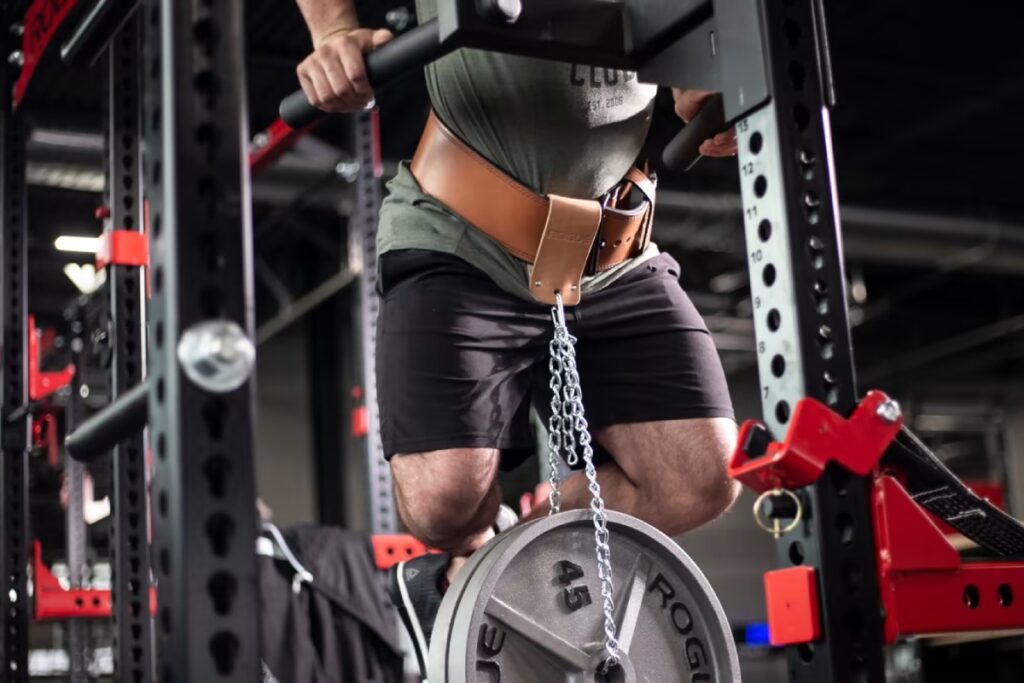
3 Disadvantages of Weighted Chest Dips
As with any movement, the possible drawbacks and risks need to be considered before performing them.
❌ Big Initial Learning Curve
Weighted chest dips aren’t easy to perform. Care needs to be taken to build upper body strength first and get used to performing bodyweight dips before progressing to weighted ones.
Even as an intermediate athlete, performing weighted dips and maintaining correct form can still prove hard. This makes the initial learning curve fairly steep.
❌ Bigger Injury Risk
When performing weighted dips, the elbow and shoulder joints come under increased pressure, especially during the eccentric lowering phase at the bottom of the movement. The shoulder and chest muscles must maximally stretch to allow the arms to reach parallel to the floor.
Any deviations in head and back position can cause the spine and shoulders to come out of the optimal lifting position, further increasing pressure and possibly leading to injury.
Alongside this, dipping past 90 degrees can also increase shoulder pressure and lead to injury. This is probably the most common weighted dip mistake.
❌ Require Some Equipment
Whilst not a big disadvantage, weighted dips require a pair of parallel bars and a dip belt to perform them. It’s something to bare in mind but not really an issue once you have the belt, with most gym areas containing parallel bars.
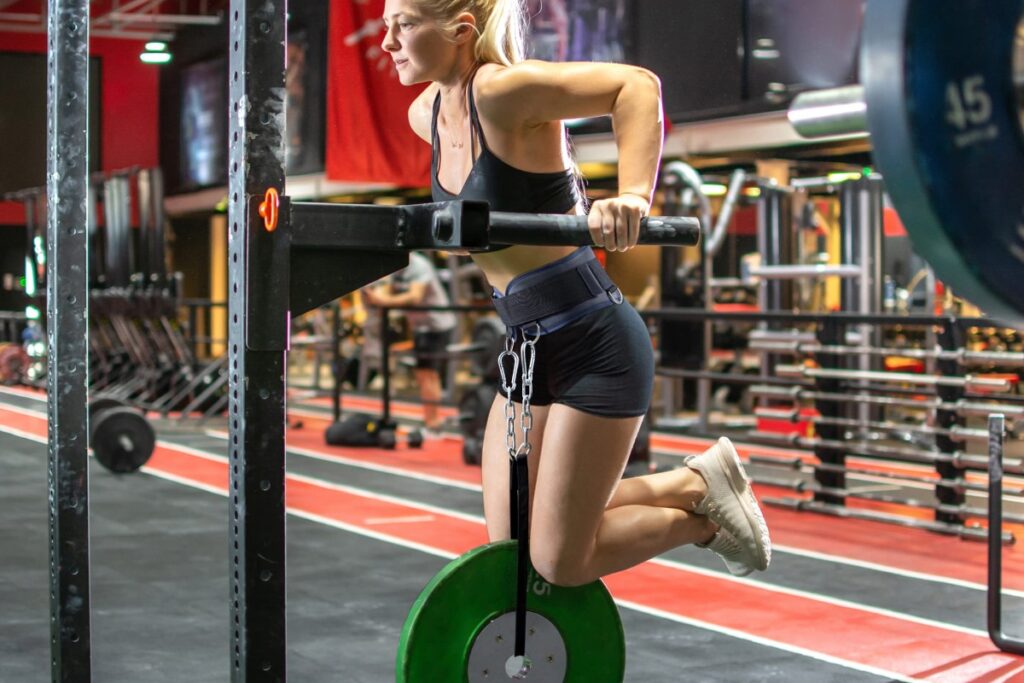
How to Do Weighted Dips?
The steps below show how to use a dip belt and how to perform weighted dips correctly. Make sure to follow them when learning how to add weight to dips:
- Assume the starting position – Wrap the dip belt around your waist and secure it into position with a weight hooked through the chain and between the carabiners. Stand between a pair of parallel dip bars on a platform and set your hands on the bars. Squeeze your shoulder blades and hands at the same time.
- Perform the eccentric portion – Brace your core and flex your elbows, lowering your body down whilst keeping your chest up and head facing forward. Lower down to a 90-degree angle before pausing briefly.
- Perform the concentric phase – Drive through your hands by using your triceps, anterior shoulders, and chest to return to the starting position. Tense your triceps at the top of the movement and repeat.
- Take the dip belt off – Once you’ve performed the required number of reps, step off the raised platform and place both feet firmly on the ground. Lower the weight down to the ground by flexing slightly at the knees and unhook the carabiner to remove it. Alternatively, you can choose to step out of the belt once the weight is on the floor.
Subscribe!
The latest reviews of must-have home gym training equipment, apparel, and supplements that will enhance your performance and bring you new results.
3 Variations and Modifications of Weighted Dips
Below are some common weighted dip variations you can perform to improve size and strength. We’ve added an easier and harder option for those at different ability levels.
1. Bench Dips
We’ve included these as a beginner-friendly exercise and perhaps the simplest version of a dip. All you need is a chair, bench, or flat surface around hip height.
Place your hands in a pronated position on the raised surface and drop your body by performing elbow flexion until around 90 degrees. Return to the starting position.
2. Ring Dips
Ring dips are one of the hardest dip variations that should only be performed at an advanced level once you’ve spent time developing your upper body and core strength.
Due to the unstable ring position, ring dips require a bigger amount of control and strength to perform successfully. They use the same movement pattern as normal dips but at a much higher difficulty.
3. Eccentric Dips
Eccentric dips focus purely on the downward phase of the lift, helping with body control when lowering the dip belt downwards.
They are also great to add to your training schedule if you struggle with the concentric phase of the dip, allowing you to overload the movement without having to lower the weight.
Start in the same position as a normal weighted dip and slowly lower down for a three count until your elbows reach parallel. Place your feet on the ground and repeat the same movement.
2 Weighted Dips Alternatives
The alternatives below can be performed as part of a weighted dips workout or added to any workout routine as needed.
1. Close-Grip Push-Ups
Close grip push-ups are a simple weighted dip alternative that work similar muscle groups and require no equipment. Start in a plank position and place your hands slightly closer than shoulder-width apart. Go into a push-up whilst keeping your elbows tucked in. Keep your core engaged to maintain a tight body position. Return to the starting position and repeat.
2. Handstand Push-Ups
Handstand push-ups are a challenging dip alternative that mainly work your shoulders and triceps.
Place your hands shoulder-width apart around 6 to 8” from a wall. Kick a foot up to the wall and let the other follow. Slowly lower your head down to the floor by flexing your elbows. Press upwards keeping your core engaged and legs together to return to the starting position.
What Is a Dip Belt?
A dip belt works the same as a normal lifting belt by wrapping around your torso, providing lumbar support when lifting.
What makes a dip belt different is the added component on the front (usually consisting of D-shaped carabiners and a chain) allowing you to perform weighted dips with dumbbells or weight plates that sit between your legs. This enhances the difficulty of dips by increasing your body weight.
Our Recommended Dip Belt – Rogue Dip Belt

The Rogue Dip Belt is constructed from high-quality 3” wide heavy-duty nylon, giving it a huge max capacity of 29,400 pounds. Basically, you’re never going to break it.
The 0.25” wide steel chain link system and D-shaped carabiners allow for easy adjustment and keep the weight plates safely secure when exercising.
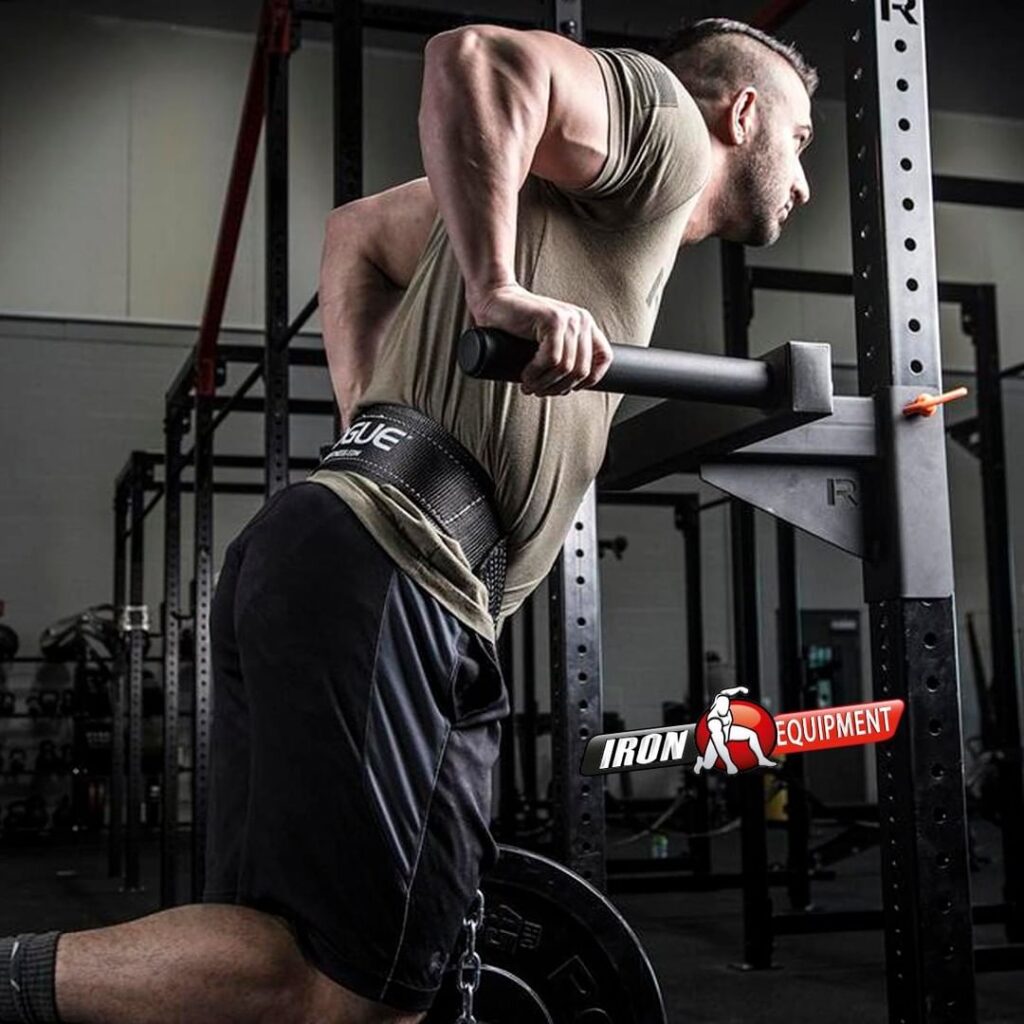
This new model features a 4” backer piece, stopping it from coming into repeated contact and improving comfort. Two color designs are available, with the white Rogue branding on the back.
FAQ
Are Weighted Dips Better Than Bench Presses?
In terms of building size and strength, barbell bench presses are the better choice. If you’re looking for a functional upper body movement that can improve shoulder mobility alongside the shape and size of your chest, triceps, and shoulders then dips are a great option.
Both exercises can be programmed into a well-organized upper body routine, complimenting each other when performed correctly.
Do Weighted Dips Grow Triceps?
Weighted dips are a great exercise for growing both the lateral and long heads of the triceps. They can help to build size, strength, and power when performed regularly.
Do Weighted Dips Hit Shoulders?
Alongside the chest and triceps, weighted dips are great exercises for hitting the shoulders. More specifically, they work the anterior shoulder muscles which are located at the front of your body.
How Heavy Should Weighted Dips Be?
The amount of weight you choose for weighted dips depends on your training goals. If you are training for strength, go for a weight that you can perform 3 to 5 repetitions with. If your main goal is hypertrophy, pick a weight that you can perform 8 to 12 repetitions with.
The process of choosing a weight to begin with will involve trial and error before you know what to use. Build up slowly and focus on correct form when progressing the weight to limit the chance of injury.
Conclusion
Weighted dips are great exercises for building upper body strength and power. They primarily target the chest, anterior shoulders, and tricep muscles. Benefits include better lockout power and overhead control. Follow the guidance above to learn how to use a weighted dip belt correctly and safely. The variations and alternatives may be used depending on your exercise goals and ability level.
What do you think of weighted dips? Are they in your current program? Do you have any suggested variations? Chat to me below.
References:
- Mirza A. Baig, Bruno Bordoni, “Anatomy, Shoulder and Upper Limb, Pectoral Muscles,” PubMed. Published 2020. Accessed December 28, 2023. Available at: https://www.ncbi.nlm.nih.gov/ books/NBK545241/
- Adel Elzanie, Matthew Varacallo, “Anatomy, Shoulder and Upper Limb, Deltoid Muscle,” PubMed. Published 2020. Accessed December 28, 2023. Available at: https://www.ncbi.nlm.nih.gov/ books/NBK537056/
- Manpreet S. Tiwana, Margaret A. Sinkler, Bruno Bordoni, “Anatomy, Shoulder and Upper Limb, Triceps Muscle,” PubMed. Published 2020. Accessed December 28, 2023. Available at: https://www.ncbi.nlm.nih.gov/ books/NBK536996/
- Lasse Mausehund, Amelie Werkhausen, Julia Bartsch, Tron Krosshaug, “Understanding Bench Press Biomechanics-The Necessity of Measuring Lateral Barbell Forces,” Journal of Strength and Conditioning Research 36, no.10 (2022):2685-2695. doi:10.1519/JSC.0000000000003948
- Dennis Landin, Melissa Thompson, Meghan Jackson, “Functions of the Triceps Brachii in Humans: A Review,” Journal of Clinical Medicine Research 4, no.10 (2018):290-293. doi:10.14740/jocmr3340w
- Antonio Paoli, Paulo Gentil, Tatiana Moro, Guiseppe Marcolin, Antonino Bianco, “Resistance Training with Single vs. Multi-joint Exercises at Equal Total Load Volume: Effects on Body Composition, Cardiorespiratory Fitness, and Muscle Strength,” Frontiers in Physiology 8 (2017):1105. doi:10.3389/fphys.2017.01105
- Alec McKenzie, Zachary Crowley-McHattan, Rudi Meir, John Whitting, Wynard Volschenk, “Bench, Bar, and Ring Dips: Do Kinematics and Muscle Activity Differ?,” International Journal of Environmental Research and Public Health 20, no.19 (2022):13211. doi:10.3390/ijerph192013211
- Testosterone Nation, “Close Grip Push-up,” YouTube, Available at: https://youtu.be/hHiUEfPlB40 ?si=mU3_fkxaNZd2ksSF (Accessed December 28, 2023)
- WODprep, “Handstand Push Ups: The Ultimate Guide,” YouTube Available at: https://youtu.be/SwTEKKU2RSU ?si=5ualzPnee7UfWCIg (Accessed December 28, 2023)
Author: Sergii Putsov
PhD in Sport Science, Olympic weightlifting, Strength & Conditioning coach and fitness expert
Sergii Putsov is a professional weightlifter with over 20 years of experience and multiple national medals. He was a member of the National weightlifting team, competing in the 94 kg weight class. Sergii holds a master’s degree in Olympic & Professional Sport Training and a Ph.D. in Sport Science. After his athletic career, Sergii transitioned into coaching and is now responsible for designing training programs, writing blog articles, providing live commentary for international weightlifting competitions, and hosting sport and fitness seminars worldwide.

